Overview
Choosing the right software development partner for your SaaS is not just important; it is essential. Defining key traits such as technical expertise, industry experience, management skills, and cultural fit is crucial to aligning with your specific project requirements. This article presents a systematic approach to selecting a partner, emphasizing thorough research and the evaluation of technical skills. Additionally, clear contractual agreements are vital to enhance the likelihood of a successful collaboration. By following these guidelines, you can ensure that your partnership is not only effective but also strategically aligned with your goals.
Introduction
Selecting the right software development partner is a crucial decision for any SaaS venture, significantly influencing project success and long-term growth. Amidst a multitude of options, it is imperative to identify a collaborator who not only possesses the requisite technical expertise but also aligns culturally and strategically with your objectives. Navigating the complexities of this selection process can be daunting; however, ensuring a fruitful partnership is achievable. This guide explores the essential criteria and actionable steps necessary to make an informed choice, laying the groundwork for a successful software development journey.
Define Your Software Development Partner
When selecting a software development partner, it is essential to define the . Consider these key factors:
- Technical Expertise: Determine the technologies and programming languages critical for your project, such as JavaScript, React, and PHP. A collaborator with a robust technical foundation can adeptly navigate complex challenges and deliver high-quality solutions. As industry experts suggest, having a software development partner with a proven track record is akin to having a seasoned navigator guiding your journey.
- Industry Experience: Look for collaborators with a demonstrated history in your sector, particularly in healthcare or SaaS. Their familiarity with industry-specific challenges and regulations can significantly enhance your project's outcomes. Evaluating a partner's background and their understanding of relevant technology trends can improve the alignment of your initiatives.
- Management Skills: Evaluate their ability to manage projects efficiently, ensuring adherence to timelines and expected outcomes. Effective project management is crucial; studies indicate that 75% of projects exceed their time and budget due to unclear requirements. Furthermore, 66% of software projects fail, leading to substantial financial losses that stem from poor collaborator selection.
- Cultural Fit: Assess how well their company culture aligns with yours. A strong cultural fit fosters collaboration and communication, both of which are vital for success. When cultures align, communication flows more smoothly, misunderstandings are minimized, and both parties are better equipped to manage and exceed expectations.
By clearly defining these criteria, you create a profile of your ideal partner, streamlining the selection process and enhancing the likelihood of a successful collaboration.
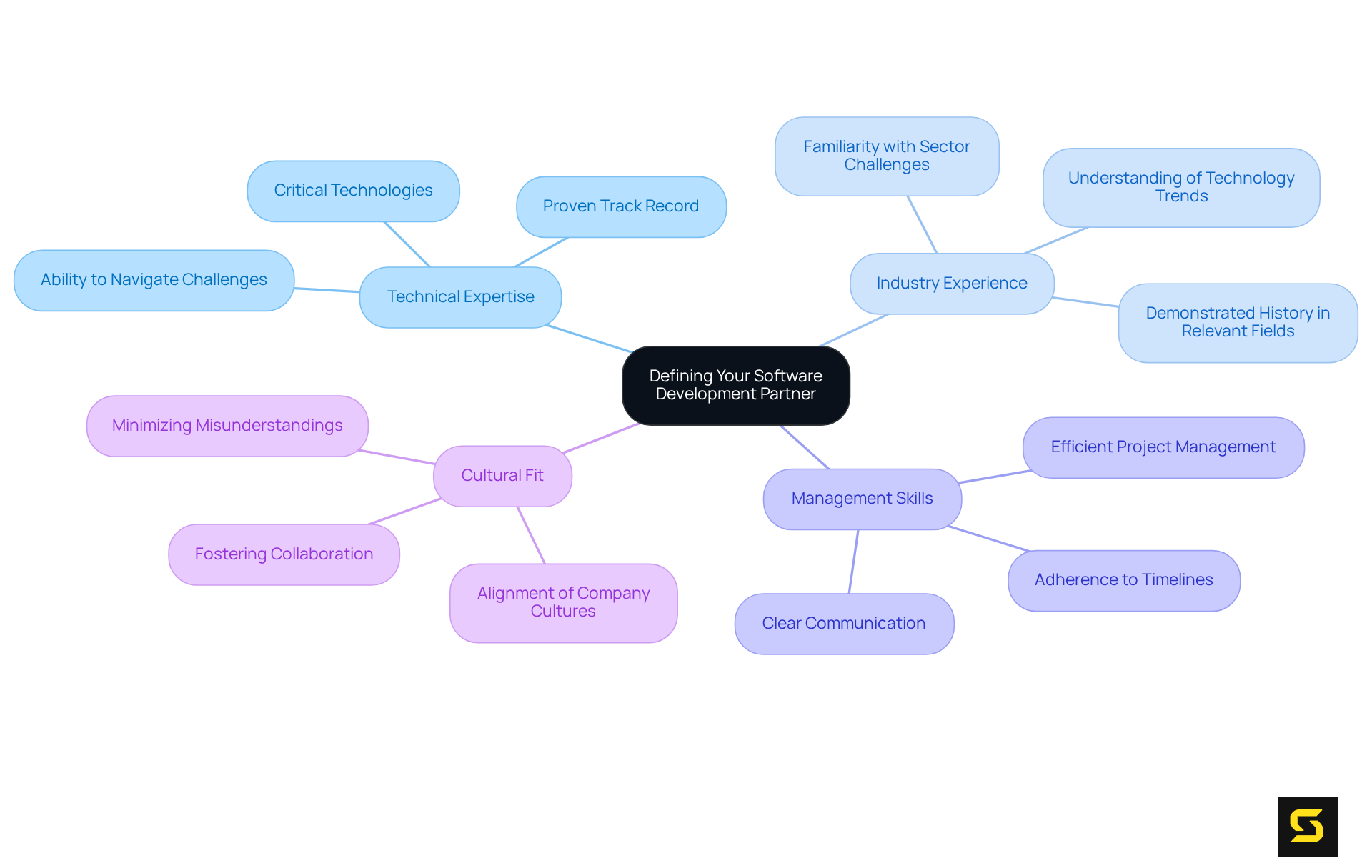
Identify Project Requirements and Goals
To effectively gather and document your project requirements and goals, it is imperative to follow these essential steps:
- Conducting Stakeholder Interviews: Engage with key stakeholders early in the strategy development phase to gain valuable insights into their needs and expectations. These interviews are crucial for comprehending the context and aligning objectives. Best practices include preparing open-ended questions, actively listening, and meticulously documenting insights to ensure all perspectives are captured. Follow-up communication, such as sending a thank-you email after interviews, not only reinforces relationships with stakeholders but also demonstrates professionalism.
- Creating User Stories: Develop user stories that vividly illustrate how different users will interact with the software. This technique is instrumental in visualizing user needs and prioritizing features based on real-world scenarios, thereby ensuring that the final product meets user expectations effectively.
- Defining Success Metrics: Establish clear metrics for success, such as user engagement rates or performance benchmarks. These metrics will guide the initiative and provide measurable outcomes to assess its effectiveness, ensuring accountability throughout the project.
- Drafting a Specifications Document: Compile all gathered information into a formal specifications document. This document serves as a vital reference throughout the project, ensuring that all stakeholders are aligned and that the development team comprehensively understands the project vision. Utilizing like Notion and Slack can significantly enhance the needs gathering process.
- Prioritizing Needs: Employ frameworks like the MoSCoW method to categorize necessities into Must-haves, Should-haves, Could-haves, and Won’t-haves. This organized method facilitates efficient handling of task specifications, ensuring that the most critical needs are addressed promptly.
By explicitly outlining your software specifications and objectives, you empower your development collaborator to synchronize their efforts with your vision, ultimately resulting in a more successful outcome.
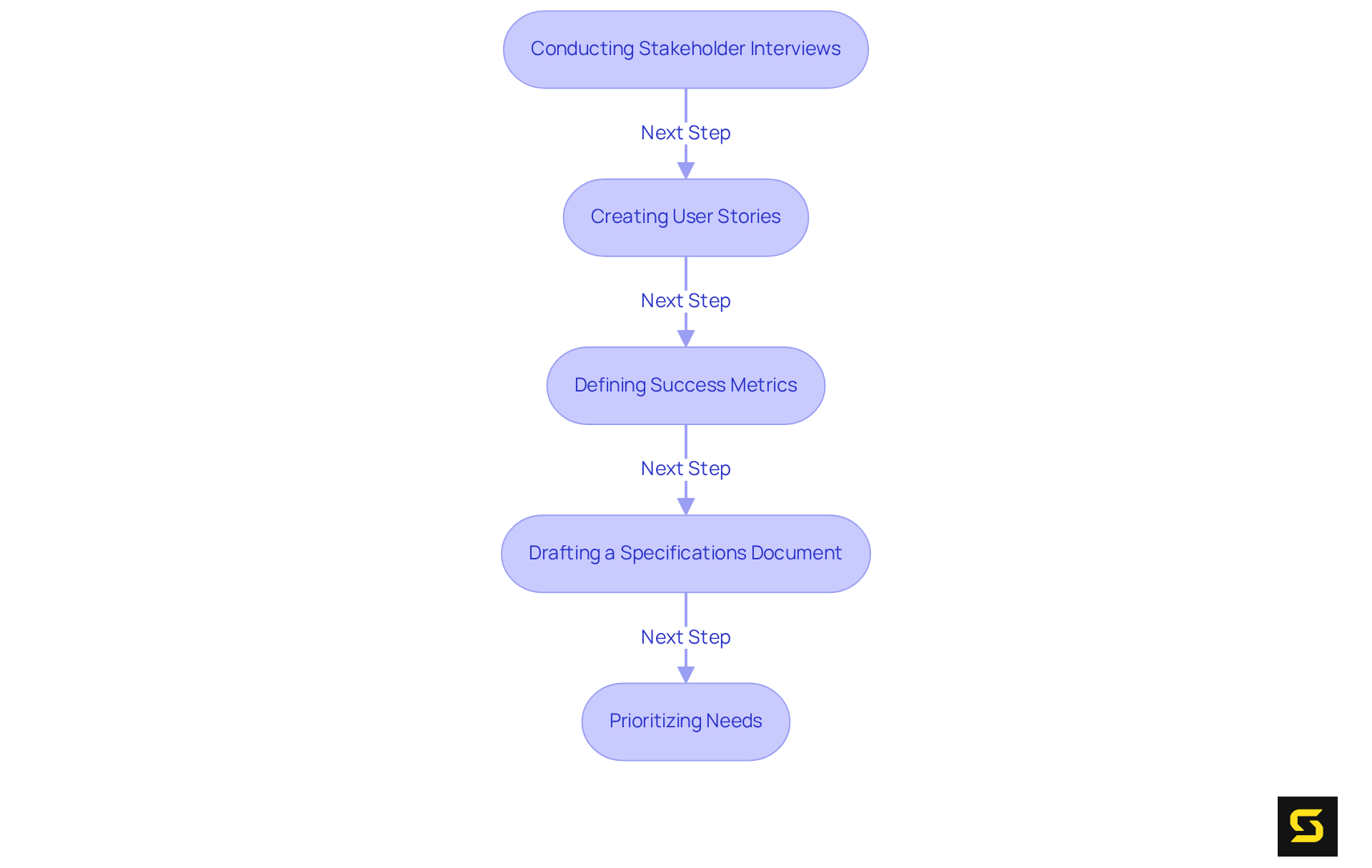
Research and Shortlist Potential Partners
Once you have defined your criteria and project requirements, it is imperative to begin your search for potential software development partners by following these essential steps:
- Utilize Online Platforms: Leverage platforms such as Clutch and Upwork to . These platforms provide valuable insights into various companies' capabilities and client feedback, ensuring you make informed decisions.
- Review Portfolios: Carefully examine the portfolios of prospective collaborators to evaluate their previous work. Seek initiatives that showcase pertinent experience and correspond with your particular requirements, ensuring they possess a verified history in your sector.
- Check References and Reviews: Seek out client testimonials and case studies that showcase the firm's successes and challenges. This feedback can provide a clearer picture of their reliability and the quality of their deliverables, reinforcing your confidence in their abilities.
- Network for Recommendations: Tap into your professional network for referrals to reputable firms. Personal suggestions can frequently result in finding reliable collaborators who have effectively completed tasks akin to yours, streamlining your selection process.
- Evaluate Ongoing Support: Assess the collaborator's ability to provide continuous assistance after completion, as this is crucial for ensuring long-term success and user satisfaction. An invaluable software development partner is one who offers ongoing support.
- Consider Market Dynamics: Be aware of market dynamics to negotiate fair pricing and contract terms, which can significantly impact your project's budget. Understanding these factors will empower you during negotiations.
- Prepare an RFP Document: Create a Request for Proposal (RFP) document with specific questions regarding the collaborator's experience and processes to facilitate a thorough evaluation. This structured approach will clarify expectations.
- Cultural Alignment: Ensure that there is cultural alignment between your organization and the software development partner, as this is essential for successful cooperation. A shared vision fosters collaboration.
- Check for Certifications: Verify that potential collaborators hold relevant certifications, such as ISO 27001 for information security, to ensure compliance and quality standards. This verification is crucial for maintaining industry integrity.
After collecting this information, create a shortlist of candidates that match your criteria and requirements, laying the groundwork for a successful partnership.
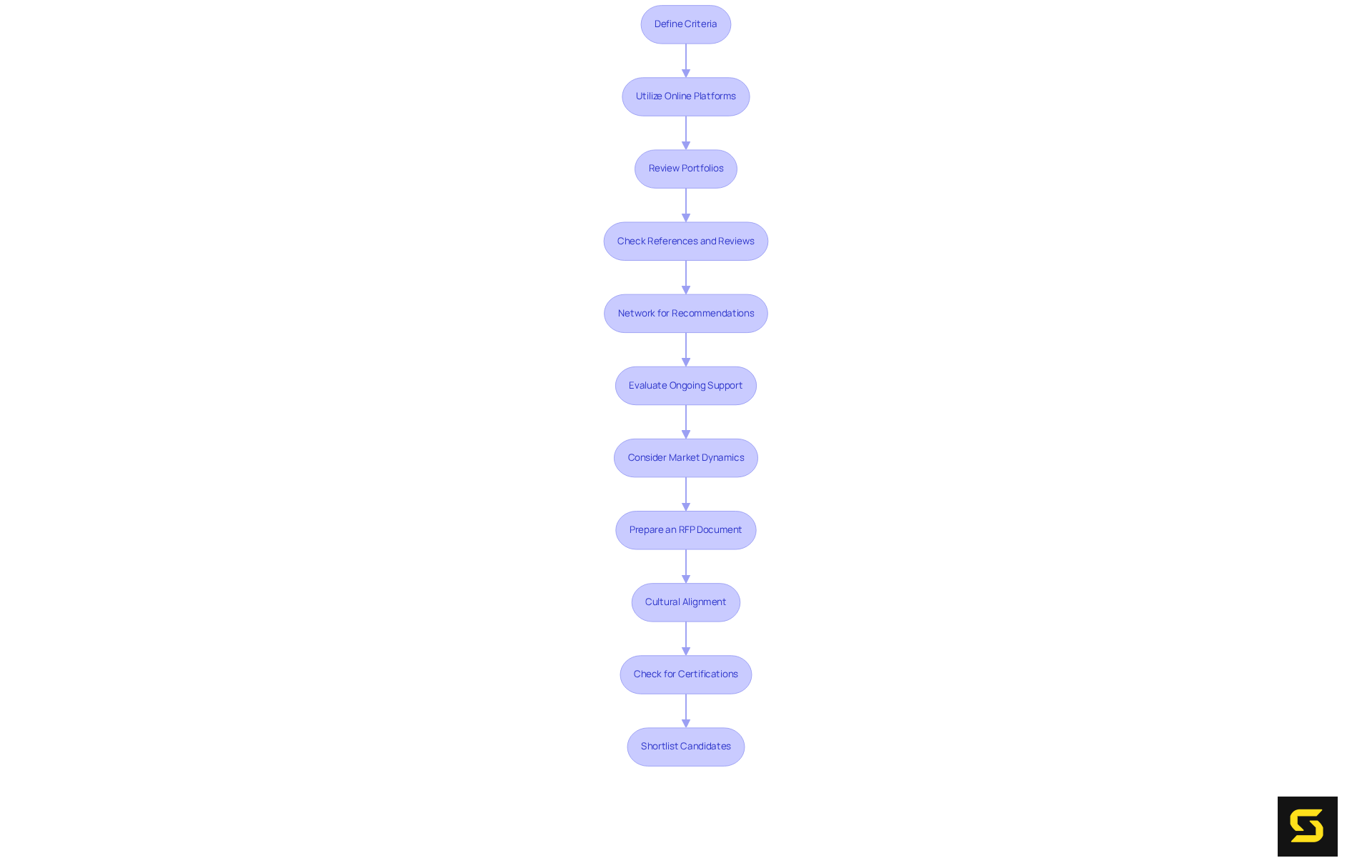
Evaluate Technical Skills and Cultural Fit
To evaluate your shortlisted partners effectively, consider the following key criteria:
- Technical Assessments: Conduct technical interviews or assessments that gauge their expertise in relevant technologies.
- Cultural Fit Assessment: Engage in discussions regarding company values, work styles, and communication practices to determine alignment.
- Management Approach: Inquire about their management methodologies, such as Agile or Scrum, to ensure they meet your expectations.
- Trial Projects: If feasible, initiate a small trial project to assess their performance and collaboration style.
By thoroughly assessing both technical skills and cultural fit, you can make a more informed choice about which collaborator will best meet your needs.
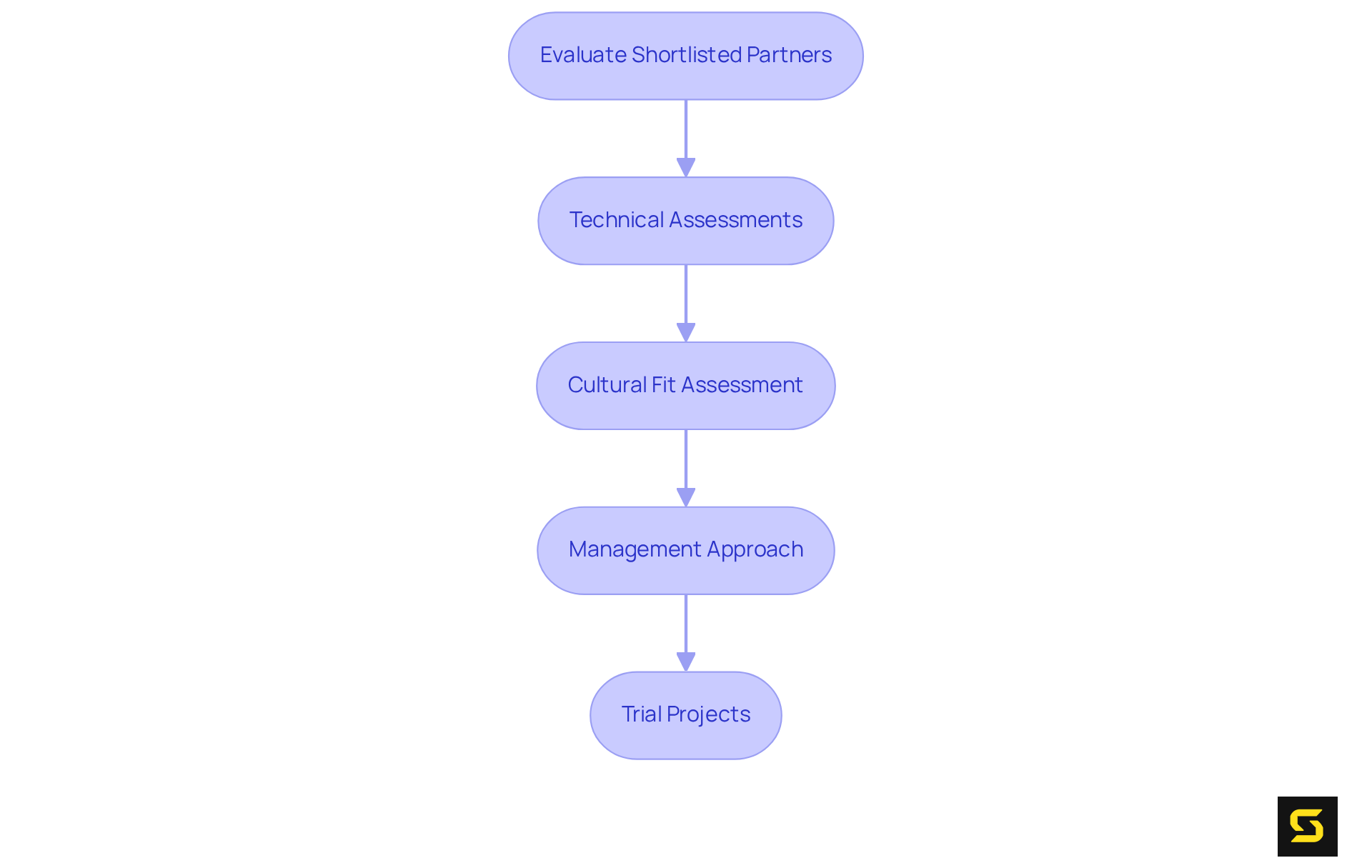
Finalize Terms and Contracts
Once you have selected a partner, it is imperative to finalize the terms and contracts. Follow these essential steps to establish a solid foundation for your partnership:
- Draft a Comprehensive Contract: Ensure that the contract encompasses crucial elements such as project scope, timelines, payment terms, and intellectual property rights.
- Negotiate Terms: Approach negotiations with a readiness to align terms that reflect the interests and expectations of both parties.
- Include Performance Metrics: Clearly define performance metrics and milestones to monitor progress and ensure accountability throughout the project.
- Legal Review: Engage legal counsel to meticulously review the contract, ensuring compliance and safeguarding your interests.
By finalizing clear and comprehensive terms, you not only set the stage for a successful partnership but also create a framework that can adapt to challenges and effectively achieve your project goals.
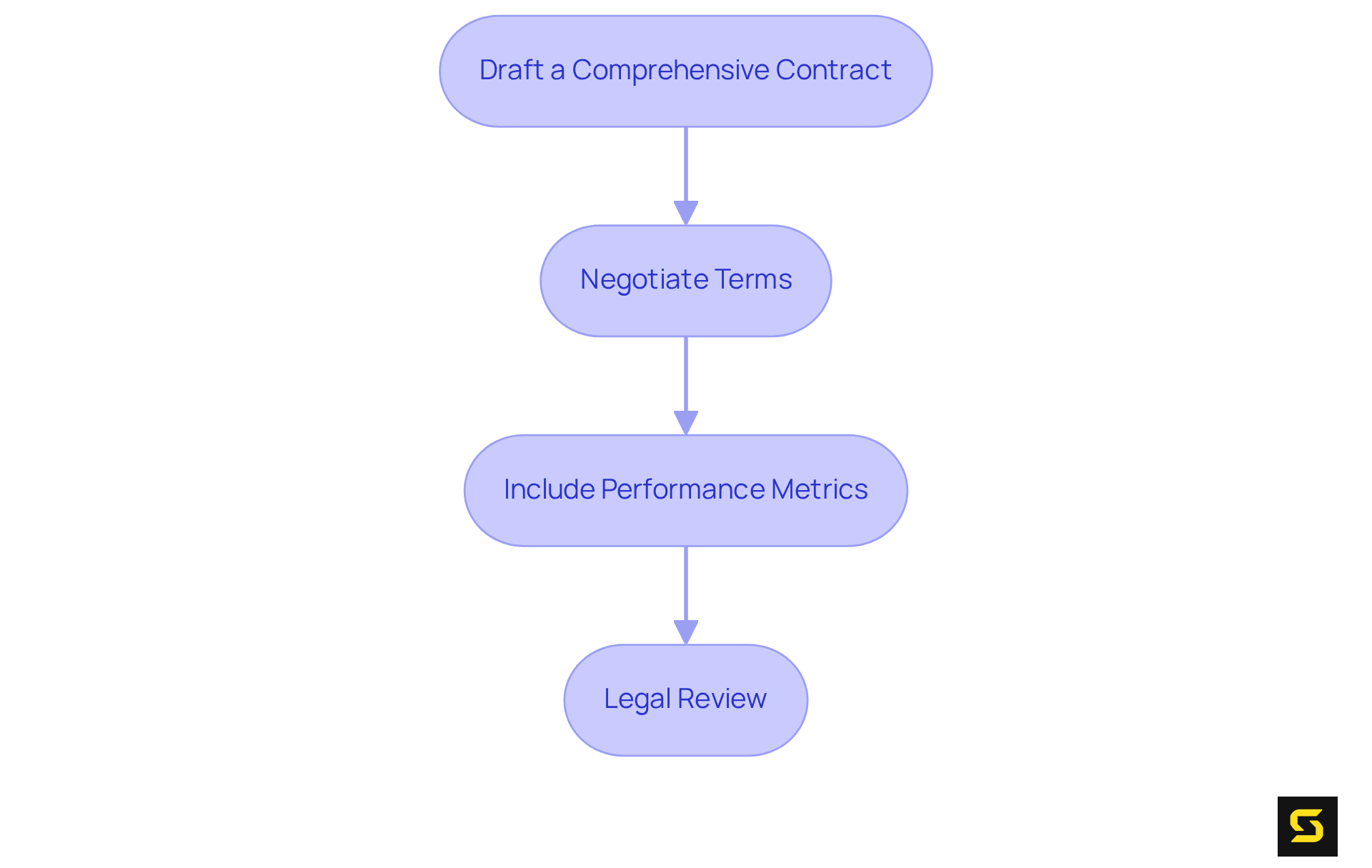
Conclusion
Choosing the right software development partner for a SaaS project is not just a decision; it's a pivotal factor that can dictate the success of the initiative. By meticulously defining the essential traits and criteria that align with specific project needs, organizations can streamline their selection process and significantly increase the likelihood of a fruitful collaboration.
Key considerations encompass:
- Technical expertise
- Industry experience
- Effective project management
- Cultural fit
These elements are crucial, as they not only empower the partner to deliver high-quality solutions but also cultivate a collaborative environment essential for navigating the complexities inherent in software development. Furthermore, thoroughly identifying project requirements, leveraging online platforms for research, and assessing both technical skills and cultural alignment lead to informed decisions that lay the groundwork for a successful partnership.
Ultimately, this process underscores the necessity of making well-informed choices when selecting a software development partner. By dedicating time to thoroughly evaluate potential collaborators and solidifying clear contractual terms, organizations position themselves to achieve their project goals and drive innovation in their SaaS offerings. The right partner has the potential to transform challenges into opportunities, making it imperative to approach the selection process with diligence and strategic insight.
Frequently Asked Questions
What traits should I consider when selecting a software development partner?
Key traits to consider include technical expertise in relevant technologies, industry experience specific to your sector, management skills for efficient project oversight, and a cultural fit that promotes effective collaboration and communication.
Why is technical expertise important in a software development partner?
Technical expertise is crucial because it ensures that the partner can navigate complex challenges and deliver high-quality solutions using the necessary technologies and programming languages relevant to your project.
How does industry experience benefit a software development project?
Industry experience allows a partner to understand sector-specific challenges and regulations, which can enhance project outcomes and improve alignment with technology trends relevant to your initiatives.
What role do management skills play in selecting a software development partner?
Management skills are essential for ensuring projects are completed on time and within budget. Poor project management can lead to significant financial losses and project failures.
How can I assess the cultural fit of a software development partner?
Assess cultural fit by evaluating how well their company culture aligns with yours, as a strong fit fosters better collaboration, communication, and minimizes misunderstandings.
What steps should I follow to gather and document project requirements and goals?
Essential steps include conducting stakeholder interviews, creating user stories, defining success metrics, drafting a specifications document, and prioritizing needs using frameworks like the MoSCoW method.
Why are stakeholder interviews important in the project development phase?
Stakeholder interviews provide valuable insights into needs and expectations, helping to align objectives and ensuring all perspectives are captured for a successful project outcome.
What is the purpose of creating user stories in software development?
User stories help visualize how different users will interact with the software, allowing for prioritization of features based on real-world scenarios and ensuring the final product meets user expectations.
How do I establish clear success metrics for my project?
Success metrics can include user engagement rates or performance benchmarks that guide the initiative and provide measurable outcomes to assess effectiveness throughout the project.
What is a specifications document, and why is it important?
A specifications document compiles all gathered information and serves as a vital reference throughout the project, ensuring alignment among stakeholders and a clear understanding of the project vision for the development team.





